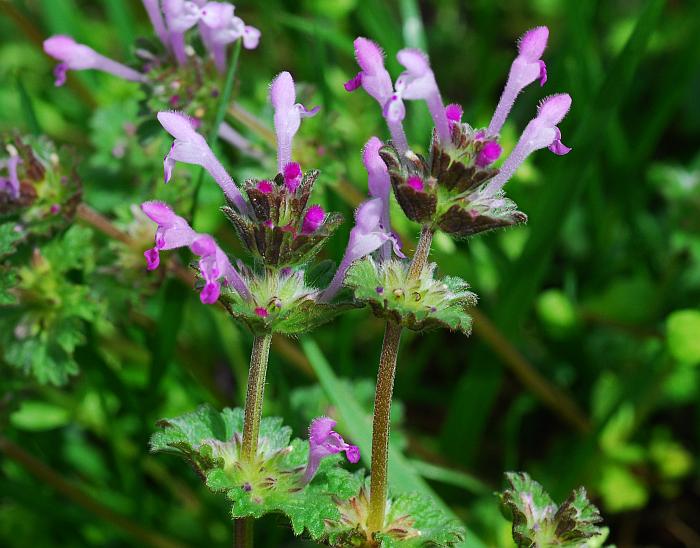Lamium amplexicaule L.
Henbit

Introduced
CC = *
CW = 5
MOC = 78
© SRTurner
Lamium amplexicaule L.Henbit | |
 |
Introduced CC = * CW = 5 MOC = 78 |
© SRTurner |
|
Family - Lamiaceae Habit - Taprooted annual forb. Stems - Ascending to erect, to 35 cm tall, often multiple from base, purplish basally, greenish above, 4-angled, hollow, usually pubescent with retrorse hairs.
Leaves - Opposite, lowest leaves petiolate. Petioles to 2 cm long. Blades unlobed or 3-lobed, to 2 cm long and broad, rotund to reniform, pubescent, the margins bluntly toothed or scalloped. Upper leaves appear clasping or perfoliate.
Inflorescences - Well-separated axillary clusters in the apical 1/2 of the stem, lacking bractlets, with 4-12 flowers per node. Cleistogamous flowers often produced.
Flowers - Calyces 5-7 mm long, the tube and lobes densely bristly-hairy, the lobes shorter than to slightly longer than the tube. Corollas (except in cleistogamous flowers) 10-20 mm long, the outer surface sparsely to more commonly densely hairy, with a very dense patch of usually longer, darker hairs on the upper lip, the upper lip 3-5 mm long, rounded to shallowly notched at the tip, pinkish purple, rarely entirely white, the lower lip 1.5-3.0 mm long, usually lighter pink or white, with purple spots or mottling, rarely entirely white, the lateral lobes reduced to small convexities along the lip margin, the central lobe obcordate. Stamens 4, didynamous, fused to the base of lower lip, included under the upper lip. Filaments white, 4-5 mm long, slightly pubescent near the base. Anthers purplish, 1 mm long. Style 1.8 cm long, white, glabrous. Stigma 2-lobed. Ovary 4-parted, light green, 1.7 mm long, glabrous. Divisions of ovary shaped like pie-pieces when viewed from above.
Fruits - Dry schizocarps, separating into 2-4 nutlets, these 1.5-2.5 mm long, obovoid, truncate at the tip, often with thickened angles, with 2 flat sides and a rounded dorsal face, the surface light brown to grayish brown or olive brown, often with lighter mottling, finely pebbled, glabrous. Flowering - February - November. Habitat - Waste ground, lawns, cultivated fields, pastures, roadsides, railroads. Origin - Native to Eurasia and Africa. Lookalikes - Lamium purpureum. Other info. - This aggressive little plant has spread throughout Missouri and nearly all of North America. The plant is tolerant of sun or shade, heat or cold. In cultivated areas that get tilled regularly, the plant can form vast seas of pink in the spring. The plant can grow from small pieces of its stem so chopping the plant only helps it spread. It also grows well from seed. Photographs taken in Brown Summit, NC., 2-4-03, and at Rock Hill Park, Boone County, MO., 3-27-04 (DETenaglia); also near Labadie, Franklin County, MO, 4-6-2008 and 4-10-2019, and near Treloar, Warren County, MO, 4-23-2014 (SRTurner). |